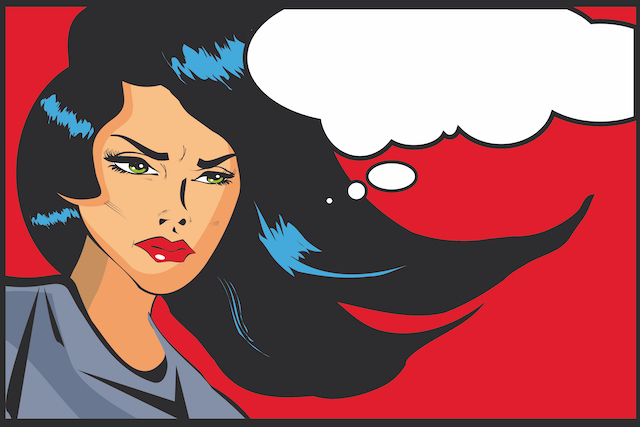
“When we embrace anger and take good care of our anger, we obtain relief. We can look deeply into it and gain many insights.” ~Thich Nhat Hanh
It just took a few words from my husband before I felt my body move from calm to a boiling cauldron of rage. My whole being was alight, in flames. Energy felt like it was moving through me and shattering everything inside me.
I hated it. Anger is so intense, and so big, that most of us can’t bear to feel it in our bodies.
I wanted to do a lot of things—shout at him, throw things, scream the house down, offer rageful thoughts to anyone who would listen.
I wanted this anger out of my body. NOW.
In the past I have reacted to these inner sensations and launched arguments that could last hours or even days. I would rarely get anything other than anger back from my husband, and a continuous wrangling over who was wrong and why.
It was painful and corroding to our relationship, feeling like a bomb would go off and we would spend days dealing with the damage.
Until I learned that the source of my anger wasn’t my husband. Or my kids, or that person on Facebook, or politicians or corrupt business people.
The source of my anger wasn’t outside of me, but within. And it was situations that were activating this anger. Until I learned how to deal with the anger, it would keep coming up over and over again, in ways that felt too overwhelming and painful for me.
I was suppressing anger most of the time because I didn’t feel safe letting it out, but when it did come out it felt too strong and too damaging. It felt repulsive, overwhelming, dominating.
Boiling rage. Painful flames of righteous anger tearing through my body. A sensation that the anger was smashing bits inside me.
Anger is a hard emotion for most of us to feel. It’s got so much energy, so much force, so much intensity to it. And as an emotion, if we express anger, we usually get the most negative response back.
Anger is frightening. It’s unbearable to hear, it sends shivers through us if we walk past someone angry and fuming.
But when we suppress anger, when we don’t allow it to come up it gets trapped in our bodies, the energy of it creating havoc inside. For me it felt like it was trapped in my jaw, which was so often sore from clenching and squeezing my muscles.
I didn’t want to feel overwhelmed by anger anymore. I wanted to be a woman who could be with it, feel it, and not explode or fall apart or trap its tension in my body.
I started to become intimate and friendly with my anger. I started to recognize when it was coming up in my body—in small doses sometimes, activating minor annoyances in my life.
“Oh, anger! There you are, I see you lurking there in the shadows.”
And the times when I would feel a huge surge of it in my body, when my kids would say something, or I’d receive an unpleasant email or read something on Facebook.
“Oh, lots of anger here now! Okay, I see your anger. You’re here, I understand.”
And by noticing when it came up inside of me, I began to see how often it was a thread in my life. And by noticing it I started, in a small way, to provide some relief for myself.
The thing that I would then do, which made such a beautiful and healing difference, especially when huge surges of anger came my way—like when my husband said that thing and I wanted to shout shout shout at him—is to give myself time, space, love and support
I stay with myself and don’t react externally.
I don’t blame what I see as the source of my anger, but really isn’t.
I tend to myself with a loving touch of my heart. (When touch on the body lasts over twenty seconds it releases oxytocin, the love hormone.)
I give myself loving words—Di, I see this anger is really painful. It’s so big, so overwhelming.
I ask myself, where is this in my body, how is it feeling?
All of this attention on myself, at my reactions and how I am feeling, gives my body the signal that I am being deeply and lovingly cared for. I am safe to feel this feeling.
I might do some relaxing breathing, giving a short inhale, followed by a long exhale which activates the rest-and-relax mode.
I stay with myself as long as the emotion is there. “I’ve got you, Di! I can be with you through this feeling. I love you, Di.”
And if I need to move and do something to help the energy pass through me, I do. I go for a walk, smash some rocks, squeeze or punch a pillow.
Why this is so very important, why this makes so much of a difference in how we handle our emotions, is that it gives us the chance to let the energy of the emotion pass through. And when we do this repeatedly, we teach our system that emotions like anger are safe to be experienced, that we can hold and support ourselves through what life brings us.
It also doesn’t make the situation worse by exploding at the person who may or may not have said or done something you didn’t like.
If this is a situation that needs to be sorted out, if what was said or done needs discussion, it is infinitely more effective to wait for your anger to move through you until you are out the other side, than to talk to someone when you are in a rage.
That’s because you are highly likely to activate their anger, as anger in others can feel like an attack on ourselves.
And when we are deeply emotional, we can’t truly hear and empathize with other people, so we are just giving a speech, which the other person can’t hear if they’re also emotional!
We risk escalating the situation further by saying and doing things we deeply regret. And, of course, we can also put ourselves in danger.
If we want to be truly heard by someone, and if we want to create change, we have to wait until the emotion has passed. Then we have the best possible chance of coming to a positive agreement with someone else about what we didn’t like or want.
Anger, like all emotions, can give us a unique understanding of what needs we have that aren’t being met. When we see the roots of what has activated the anger, we can see that there are often unmet needs to explore.
For me, after that big rageful explosion, after I moved through the flames of anger and out the other side, I saw that I wanted more private space for myself to work uninterrupted so I could fully concentrate.
It was a need I had been thinking about on and off for a while, but that I hadn’t really realized that it was upsetting me. It gave me the sense that I was last on the priority list as everyone else in the family had a space for private time.
And so seeing that, I could then work on meeting that need, and reducing the chances of anger being activated around that subject again.
Anger, what are you trying to tell me? I asked, and it told me.
About Diana Bird
Diana Bird is a Neuro-Emotional coach and writer who helps people break free from overwhelm, panic and dread, stepping into calm and confidence. Sign up for her free emotional-processing mini workshop and receive powerful tools, free training, and ongoing support to transform your emotional well-being. Take the first step toward lasting emotional change. Diana lives in southern Spain with her two children and photographer husband.













 Though I run this site, it is not mine. It's ours. It's not about me. It's about us. Your stories and your wisdom are just as meaningful as mine.
Though I run this site, it is not mine. It's ours. It's not about me. It's about us. Your stories and your wisdom are just as meaningful as mine. 